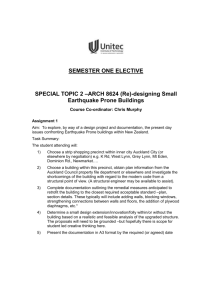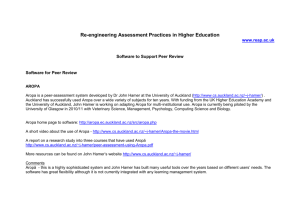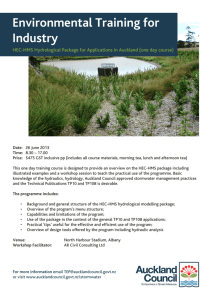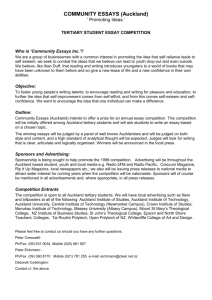Economics of LIUDD - Landcare Research
advertisement
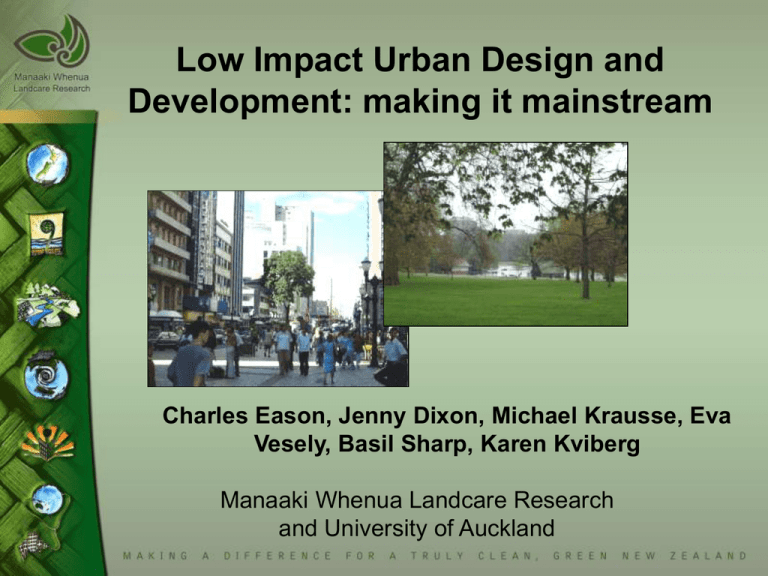
Low Impact Urban Design and Development: making it mainstream Charles Eason, Jenny Dixon, Michael Krausse, Eva Vesely, Basil Sharp, Karen Kviberg Manaaki Whenua Landcare Research and University of Auckland Urban research for change Conservation Subdivision Settlement Form and Futures: • Taxonomy • Rating • Futures Self-Sufficient Neighborhoods Urban ecological restoration Household Dynamics LIUDD: • Getting buy in • Technological and Ecological efficiency • Economic viability • Supportive plans and practice Sustainable Buildings: • Tamaki Rating and Assessment Key Issues and Challenges Issues • Sprawl and loss of green space • Contamination of urban and surrounding environments • Inefficient use of energy, water, and infrastructure • Conflicting priorities in an adversarial planning environment LIUDD Challenges • Enhance liveability • Protect and incorporate natural systems and technological advances • Reduce energy demand, waste generation, infrastructure costs • Align planning processes Goal: 30% new urban developments take LIUDD approach by 2008 The Way Forward Getting buy-in (1) Demonstrate technical + ecological efficiency (2,3) Four-pronged approach Demonstrate economic viability (4) Develop supportive plans and codes of practice (5) What’s the economic problem? Context • Demand for enhanced urban drainage is growing – New development (infill and green field) – Landowners subject to localised flooding • Receiving environments are deteriorating Symptom • Uptake of LIUDD is limited • No source control – Emphasis on engineered drainage solutions – Reliance on education and some enforcement Diagnosis • Insufficient information • Inadequate policies and processes What do we need to know? A Cost Benefit Approach • What level of avoidance, mitigation, or remedy is appropriate? – How do we fairly and efficiently charge for services and benefits? – Will price alter consumer use of energy, water, and waste services? • What are the costs and benefits of using a low impact approach to urban design and development? – What are the relative costs of conventional and LID approaches? – Is a low impact approach economically rational for the private land owner or developer? What do we need to change? An Institutional Approach • Reduce costs of adopting a low impact approach – Improving understanding: developers, purchasers, Councils – Developing technical standards • Reduce additional costs of LID options – At establishment (consultation, legal) – In operation (maintenance, monitoring) • Distribute the costs fairly and efficiently – Equalising marginal abatement costs – Targeted rates, charges and contributions FRST Contract Target outcome: • A mix of private and public investment in LIUDD that maximises benefit to the community. Purpose: • Determine the private and public benefits and costs of LIUDD at different spatial scales (household, neighbourhood, catchment). • Evaluate alternative institutional mechanisms to maximise community benefit from urban development. LIUD Device Database and Models (Eva Vesely, Michael Krausse, ARC, Monash) Issue and objective: • What are the relative costs and performance of conventional and LID approaches in New Zealand? • Develop an “open-access” living database of cost and performance data for LID devices in New Zealand. Progress to date: • Survey of TAs nation wide for available data. • Partnership with the ARC and Monash University • Developed a New Zealand data protocol for collecting construction and operating cost data for stormwater devices. • Collected data from 7 Auckland TAs Total acquisition costs Use and maintenance & renewal and adaptation costs Initially elevated maintenance costs (e.g. landscaping) Real Cost (noncumulative) Disposal costs Infrequent costs to maintain the measure’s performance (e.g. replacement of a gross pollutant trap’s screen) Time Construction Detailed design and development Renewal / adaptation costs Preliminary design Conceptual design Definition of need Source: Andre Taylor, CRC Catchment Hydrology Typical annual maintenance costs Decommissioning costs Greenfield Constructed Wetlands: Total acquisition cost [TAC] vs. Treatment zone area [A] TAC [2004 AUD$] 10,000,000 Predicted TAC 1,000,000 Actual TAC data High estimate [68% prediction interval] Low estimate [68% prediction interval] Predicted TAC 100,000 Regression information: 2 0.6435 p < 0.01, R = 0.80 (very strong), TAC = 1910.7(A) 10,000 100 1,000 10,000 2 A [m ] Source: Andre Taylor, CRC Catchment Hydrology 100,000 Auckland LCC Device Database Sediment basins and ponds Online wet 33 Offline wet 10 Dry 14 Constructed wetlands Gross Pollutant Traps Bioretention devices 8 Proprietary devices 29 Litter traps 20 Swales, Filter strips 11 Rain gardens 9 Infiltration systems 17 Sand filters 11 Sediment traps 4 Rainwater tanks 1 LIUD Device Database and Models Plans for the next 12 months: • Establish and deliver a New Zealand life cycle cost database. Challenges: • How do we encourage uptake of the data protocol? • How do we overcome the barriers to data gathering and sharing? Life-cycle Analysis (Robbie Andrew, Eva Vesely) Issue and Objective: • Are low impact devices really all that environmentally friendly? • Assess the “cradle to grave” environmental impacts of a low impact stormwater management device and its conventional alternative. Progress to date: • Developed data collection and analysis procedures and experience. • Identified a case study rain garden (under construction) Life-cycle Analysis (Robbie Andrew, Eva Vesely) Life-cycle Analysis Plans for the next 12 months: • Complete LCA of the Paul Matthews Road rain garden and an equivalent (detention pond). Challenges: • What will the LCA results reveal c.f. whole life costing? • Will LCA prove to be a cost effective analytical tool for TAs? LIUDD Case Studies (Eva Vesely & Michael Krausse) Issue and Objective: • The theory is fine, what happens in practice? • Evaluate the economic costs and benefits of LIUDD implemented at the subdivision or development scale. Progress to date: • Completed a review of the introduction of on-site stormwater management to Glencourt Place, North Shore City. Glencourt Place Case Study NPV Comparison ($000) 50 years 100 years 3.5% 10% 3.5% 10% Conventional 619 612 621 612 Low impact 703 639 732 640 Difference +14% +4% +18% +5% Low impact with water savings 643 612 661 612 Difference +4% - +6% - LIUDD Case Studies Plans for the next 12 months: • Initiate a comparative evaluation of a green-fields LIUDD case study. Challenges: • Majority of case studies are rural residential. • What are the implications of the distribution of costs and benefits between stakeholders? • How do we link device and treatment train performance data with environmental benefits valued by the community? Market acceptance of LIUDD (Basil Sharp & Michael Krausse) Issue and Objective: • Does LIUDD affect the market value of properties? • Complete a hedonic price survey of residential sales in Auckland to determine the impact of environmental variables. • Identify and evaluate the impact of LIUDD elements on property value and sale price. Progress to date: • Preliminary hedonic analysis complete. Market acceptance of LIUDD Plans for the next 12 months: • Complete and present results of the hedonic survey. • Complete a qualitative comparative survey of residential property owners with and without LIUDD elements. Challenges: • How do we draw lessons from low impact rural residential development for medium/high density urban development? Public benefits of LIUDD (Basil Sharp) Issue and Objective: • What value does the community place on the ecological health of receiving environments (urban streams, estuaries, harbours, beaches)? • Complete choice modelling surveys of values placed on changes in environmental condition of receiving environments. • Evaluate the impact of LIUDD elements on environmental outcomes. Progress to date: • Completed contract report on values associated with urban stream health for ARC. Public benefits of LIUDD Part Worths ($/hhld/ann) Natural Stream Degraded Stream North Shore South Auckland North Shore South Auckland Water clarity 66 67 48 73 Native fish spp. 11 5 4 0 Fish habitat -1 -3 13 5 Moderate native vegn. 28 16 21 36 Plentiful native vegn. 21 41 20 55 Source: Kerr and Sharp 2003, AERU Research Report 256, Lincoln University Public benefits of LIUDD Plans for the next 12 months: • Complete a choice modeling survey of values associated with coastal receiving environments for ARC. Challenges: • How do we incorporate these values in decision making about policy, service provision, rating and charges? Efficient institutions and funding (Michael Krausse, Geoff Hunter, Basil Sharp) Issue and Objective: • Do the present structures (industry, local government) and funding mechanisms facilitate low impact development? • Evaluate potential stormwater management options and organisational and funding arrangements to implement these. Progress to date: • Discussion papers in preparation: – The influence of the current land development process on adoption of LIUDD – Funding options for sustainable stormwater management Efficient funding options Efficient mitigation • Appropriate levels of service • Effective targeting of effort Efficient charging • Targeted rates • Road user contributions • Efficient development and financial contribution mechanisms Efficient institutions and funding Plans for the next 12 months: • Identify and prioritise opportunities and constraints for alternative models under the LGA • Further develop high priority models. Challenges: • How do we distribute and incentivise abatement efficiently? • What should be the balance between fixed discharge limits, targeted rates, development charges and contributions, incentives etc? • What are the implications for monitoring and enforcement costs? Water pricing and sustainable water use (Karen Kviberg & John Craig) Issue and Objective: • What would sustainable water use look like? • What determines public acceptance of water pricing proposals? • Develop policy recommendations to achieve sustainable water use. Progress to date: • Successful University of Auckland Doctoral scholarship application. • Project proposal complete, literature review and method development complete. Water pricing and sustainable water use Plans for the next 12 months: • Collection of water consumption data from TAs in Auckland, Wellington and Christchurch • Complete willingness to pay survey of 500 households in Auckland, Wellington and Christchurch. What’s next Challenges • How do we ensure effective use of economic information when infrastructural alternatives are being considered? • Changing property rights requires community acceptance, political will, or compensation. How do we facilitate the development of the conditions for change? Accessing Information and Contact Details www.landcareresearch.co.nz/research/urban/


